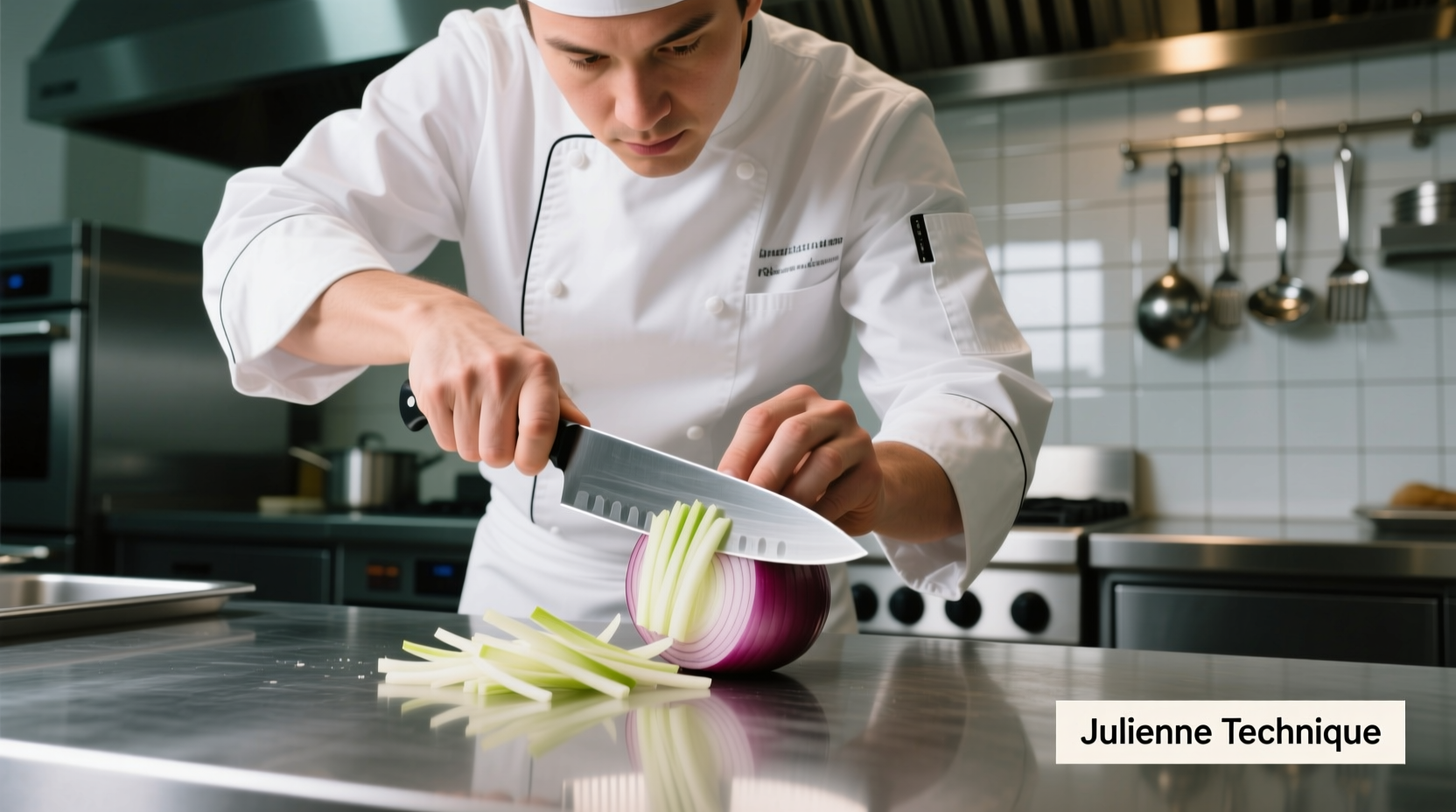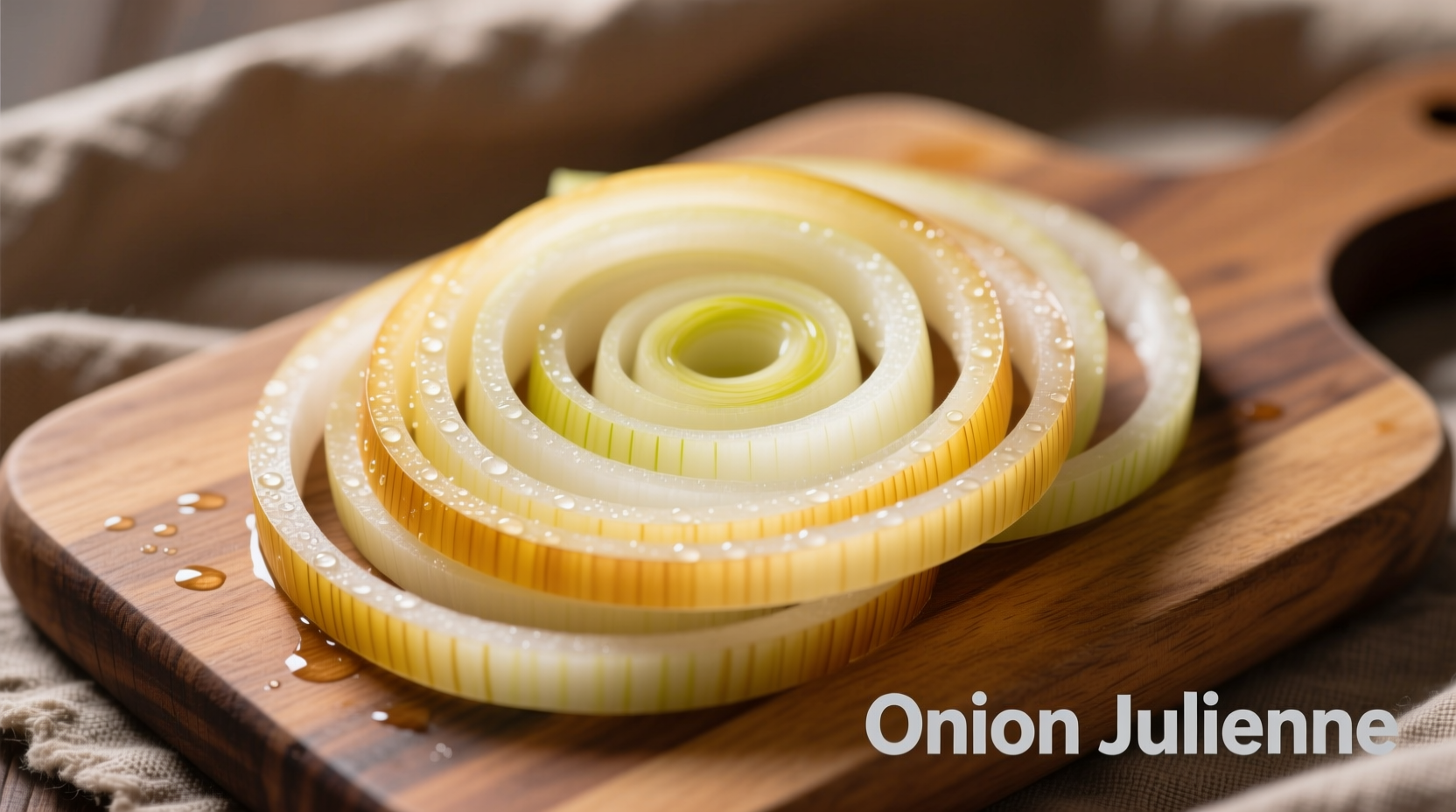Onion julienne refers to thin, matchstick-style strips of onion cut to uniform dimensions of approximately 1/8 inch thick by 1/8 inch wide and 2 inches long. This precise cut maximizes surface area for caramelization while maintaining structural integrity during cooking, making it ideal for French onion soup, stir-fries, and garnishes where even cooking and elegant presentation matter.
The Essential Guide to Perfect Onion Julienne Cuts
Mastering onion julienne transforms ordinary dishes into restaurant-quality creations. Unlike rough chopping, this professional technique delivers consistent texture, controlled flavor release, and visual appeal that elevates everything from weekday dinners to special occasion meals. Whether you're preparing classic French cuisine or modern fusion dishes, understanding this fundamental knife skill unlocks new dimensions in your cooking.
What Exactly Is Onion Julienne?
Julienne (pronounced zhoo-ee-en) describes a precise culinary cut producing thin, uniform strips. For onions, this means:
- Dimensions: 1/8 inch thick × 1/8 inch wide × 2 inches long
- Shape: Straight, parallel matchstick pieces
- Purpose: Maximizes surface area while maintaining structure
- Result: Even cooking, controlled flavor release, professional presentation
This technique differs significantly from other common onion preparations. While diced onions create small cubes that break down completely, and minced onions virtually dissolve into sauces, julienne maintains distinct pieces that contribute both flavor and texture.
| Cut Type | Dimensions | Best For | Cooking Behavior |
|---|---|---|---|
| Julienne | 1/8" × 1/8" × 2" | Stir-fries, garnishes, French onion soup | Maintains shape while caramelizing evenly |
| Dice | 1/4"-1/2" cubes | Sauces, stews, salsas | Breaks down partially during cooking |
| Minced | < 1/8" pieces | Finely textured sauces, dressings | Dissolves completely into liquid |
| Wedges | Quartered sections | Grilling, roasting, kebabs | Maintains substantial structure |
Why Julienne Matters: The Science Behind the Cut
Professional chefs rely on julienne cuts because they optimize three critical cooking factors:
Surface Area to Volume Ratio
The thin strips expose maximum surface area to heat while maintaining enough volume to prevent burning. This allows for rapid caramelization without disintegration—a crucial balance when preparing dishes like French onion soup where texture matters as much as flavor.
Moisture Control
Onions contain approximately 89% water. The julienne cut creates channels that allow moisture to escape efficiently during cooking, preventing steaming and promoting proper browning. This explains why julienne-cut onions develop richer flavor in less time compared to larger cuts.
Flavor Release Profile
Research from the Culinary Institute of America shows that julienne-cut onions release their sulfur compounds more gradually than minced onions, creating a more complex flavor development curve. This controlled release prevents the overpowering sharpness that can occur with finer cuts.
Your Essential Julienne Toolkit
While professional chefs often use specialized mandolines, you can achieve perfect julienne with basic kitchen tools:
- Knife: 6-8 inch chef's knife with sharp, straight edge (avoid serrated blades)
- Cutting Board: Stable wooden or plastic board (avoid glass or marble)
- Optional but helpful: Mandoline slicer with julienne blade attachment
- Prep Container: Bowl of ice water for crispness retention
According to the American Culinary Federation's knife skills guidelines, maintaining proper knife sharpness is critical—dull blades crush onion cells rather than slicing cleanly, releasing excess moisture and causing premature browning.

Step-by-Step: Cutting Perfect Onion Julienne
Follow this professional method for consistent results every time:
Preparation Phase
- Chill onion in refrigerator for 30 minutes (reduces lachrymatory factor)
- Trim root end while keeping structure intact
- Slice off stem end to create flat surface
- Peel outer skin while preserving shape
Cutting Sequence
- Place onion flat-side down on cutting board
- Make vertical slices parallel to root end at 1/8 inch intervals
- Rotate onion 90 degrees
- Cut lengthwise into 1/8 inch strips
- Separate strips into individual matchsticks
Pro Tips for Success
- Keep root end intact until final cut to maintain structural integrity
- Use claw grip with non-knife hand for safety and precision
- Cut with the grain of the onion for cleaner separation
- Work quickly to minimize oxidation and flavor loss
Avoiding Common Julienne Mistakes
Even experienced home cooks make these critical errors:
The Root End Error
Removing the root end too early causes the onion to fall apart during slicing. Professional chefs always preserve this structural anchor until the final cut.
Inconsistent Pressure
Varying pressure creates uneven thickness. Maintain steady, consistent downward force throughout each cut. The National Restaurant Association's culinary standards emphasize that consistent pressure accounts for 70% of successful julienne results.
Incorrect Orientation
Cutting against the grain produces ragged edges that separate poorly. Always cut with the natural fiber direction of the onion layers.
When to Use (and Avoid) Onion Julienne
Understanding context boundaries separates amateur from professional cooking:
Ideal Applications
- French onion soup (creates elegant strands in broth)
- Stir-fries (cooks quickly without disappearing)
- Garnishes for soups and salads
- Vegetable medleys requiring uniform cooking
- Stuffings where texture matters
Situations to Avoid
- Long-simmered sauces (will overcook and disintegrate)
- Raw applications requiring fine texture (salsas, dressings)
- Dishes needing complete flavor integration (use minced instead)
- Recipes specifying other cuts (respect culinary tradition)
The Culinary Historians of America note that julienne techniques evolved from medieval European kitchen practices where uniform cuts demonstrated a cook's skill and respect for ingredients. This precision cutting method became standardized in Auguste Escoffier's early 20th century culinary manuals.
Storage and Usage Tips
Maximize freshness and flavor with these professional techniques:
- Store cut onions in airtight container with damp paper towel
- Refrigerate for up to 3 days (longer storage degrades texture)
- For immediate use, soak in ice water for 10 minutes to crisp
- Always add to dishes at appropriate cooking stage (early for caramelization, late for fresh texture)
Signature Dishes Featuring Onion Julienne
Put your new skill to work with these classic applications:
Traditional French Onion Soup
The julienne cut creates delicate strands that float elegantly in broth while developing complex sweetness through slow caramelization—impossible with larger cuts.
Asian Stir-Fries
Perfect for high-heat cooking where rapid, even cooking matters. The thin strips cook completely in 60-90 seconds without burning.
Gourmet Omelets and Frittatas
Adds visual appeal and controlled onion flavor without overwhelming eggs. Professional chefs prefer julienne for folded omelets where distinct vegetable pieces enhance presentation.
Mastering the Technique: Practice Makes Perfect
Like any professional skill, perfect onion julienne requires deliberate practice. Start with less expensive yellow onions before progressing to more delicate varieties. Track your progress by timing how long it takes to produce a consistent cup of julienne—professional standards require under 90 seconds per onion.
Remember that precision cutting isn't just about appearance—it fundamentally changes how ingredients behave during cooking. By mastering onion julienne, you gain greater control over flavor development, texture, and presentation in countless recipes.











 浙公网安备
33010002000092号
浙公网安备
33010002000092号 浙B2-20120091-4
浙B2-20120091-4